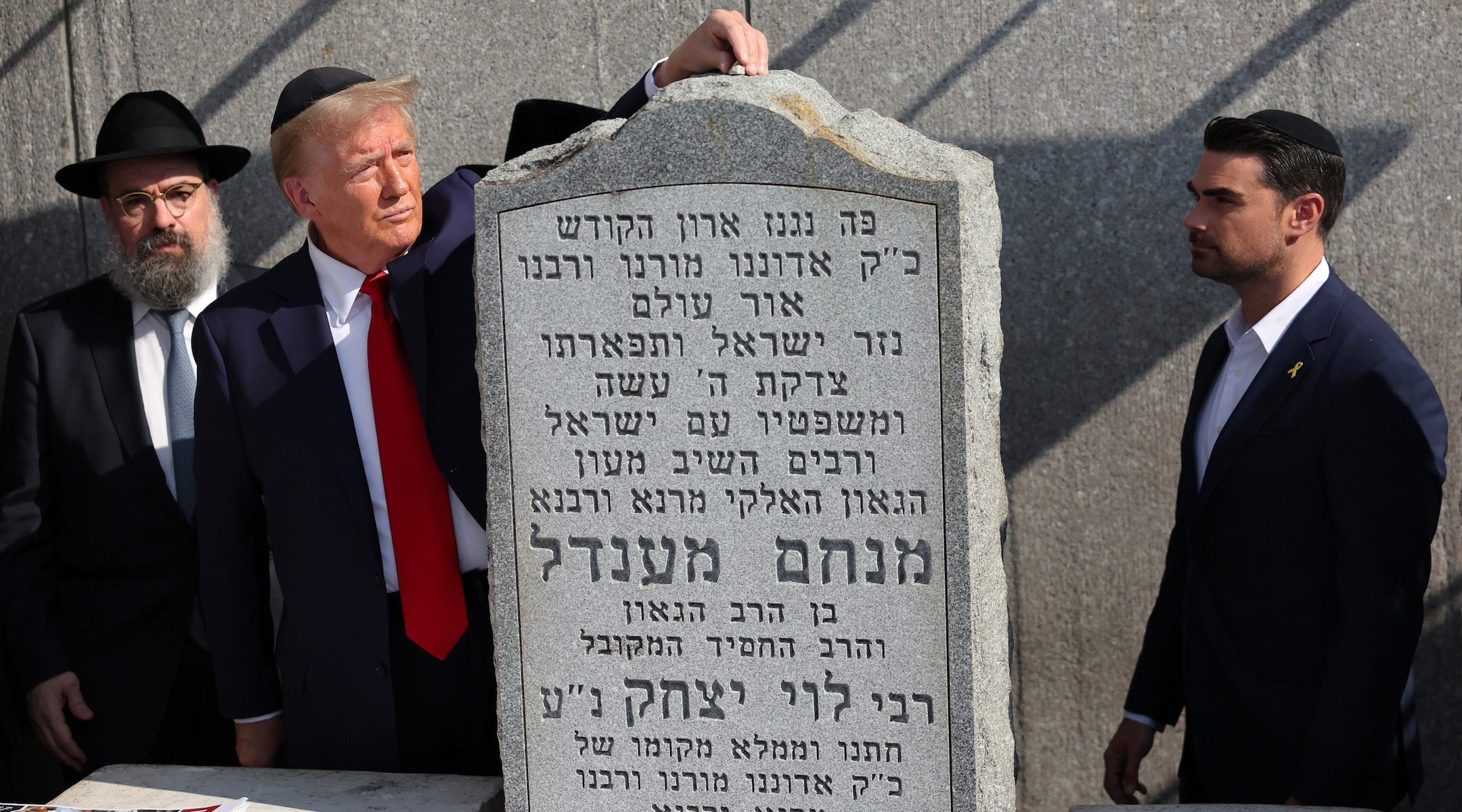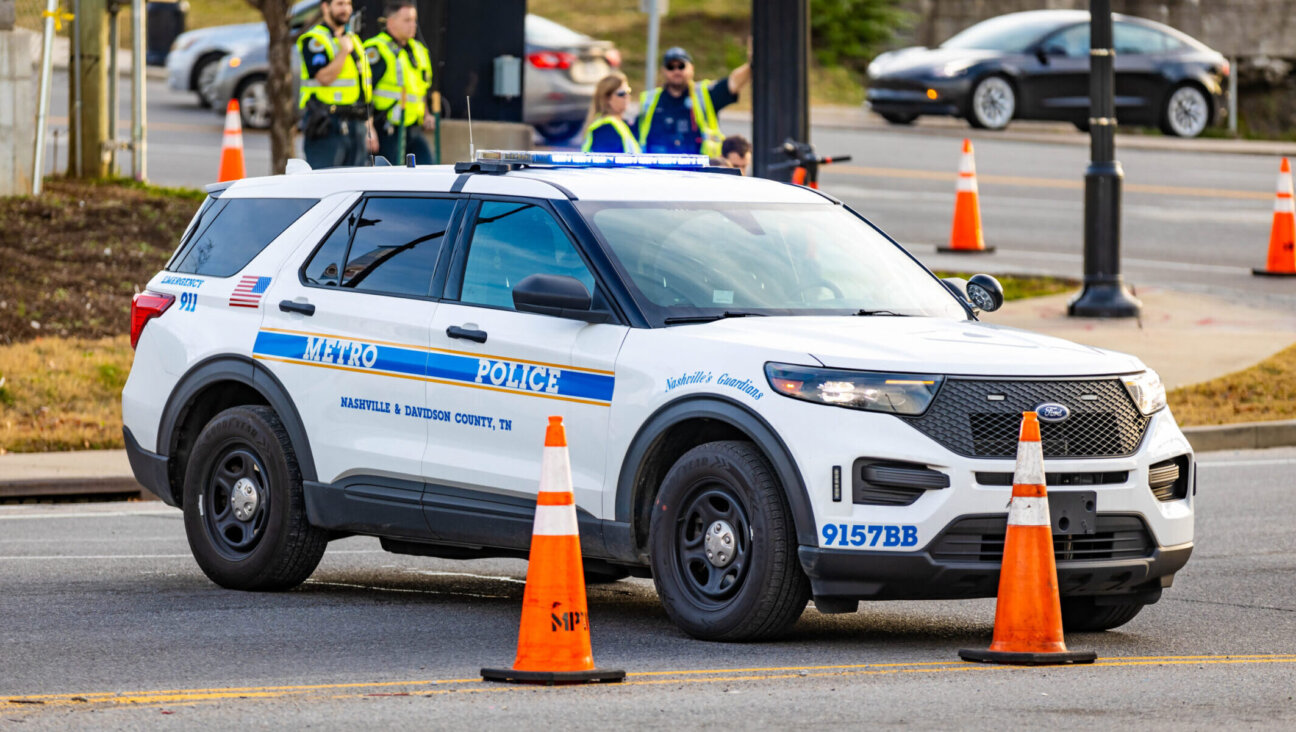Trump visits gravesite of Lubavitcher Rebbe to mark Oct. 7 anniversary
The visit was not a campaign stop but served as a gesture to a Jewish constituency that is expected to support him in next month’s election

Republican presidential nominee Donald Trump, places a rock on the gravestone of Rabbi Menachem Mendel Schneerson as Ben Shapiro watches at Ohel Chabad Lubavitch on October 7, 2024 in New York City. (Michael M. Santiago/Getty Images)
(New York Jewish Week) — Donald Trump visited the gravesite of the Chabad Hasidic movement’s late leader on Monday to mark the one-year anniversary of the Oct. 7 attack on Israel.
The former president’s visit to the Queens grave of Rabbi Menachem Mendel Schneerson, known as the Rebbe, was thick with ritual and symbolism. And he came to the site, known as the Ohel, with an entourage of prominent supporters, a Holocaust survivor and the family of a hostage held by Hamas in Gaza.
The visit was not a campaign stop in Trump’s bid to retake the White House but served as a gesture to a constituency — Orthodox Jews — that is expected to support him in next month’s election. Last month Trump was scheduled to visit a kosher restaurant in Williamsburg, home to another Hasidic movement, and drew significant excitement, but the trip was called off amid the unexpected death of the restaurant owner.
Trump did not speak publicly at the Ohel but was received warmly by the small crowd that greeted him. The site is usually open 24 hours a day and, according to Chabad, has hundreds of thousands of visitors per year, but it was restricted and under heavy security on Monday during Trump’s stop there.
“It’s gonna work out, we’re gonna make it work out, we’ve gotta get that guy back, right?” Trump said at one point during the visit. He appeared to be referring to Edan Alexander, an American-Israeli held hostage for a year in Gaza whose parents and brother accompanied Trump on the visit. Later, Trump took a photo with an Israeli hostage poster.
Video of Trump placing a personal note and praying at the Ohel of the Chabad-Lubavitcher Rebbe in Queens. https://t.co/olydriJjRG pic.twitter.com/vqOGMTsaO2
— Jacob N. Kornbluh (@jacobkornbluh) October 7, 2024
Standing alongside the grave next to Chabad representatives, Trump engaged in a series of traditional Jewish mourning practices. He donned a kippah, read a chapter of Psalms that is quoted in the daily Jewish penitential prayer, placed a note on the grave and then laid a small stone on the headstone. He also lit a yahrzeit memorial candle, something President Joe Biden also did in commemoration of Oct. 7.
Police barricades closed off streets for several blocks around the site. At the entrance to the site, Secret Service agents searched bags and scanned visitors with a metal detector. Other agents were visible standing on the rooftop of a structure on the cemetery, and a helicopter buzzed overhead. The crowd dispersed after Ohel security announced that Trump would not use the building’s regular entrance.
Politicians across parties from the United States and Israel have visited Schneerson’s resting place in the Old Montefiore Cemetery — including Trump’s daughter Ivanka and her husband Jared Kushner, who advised Trump when he was in office. Later on Monday Trump planned to hold a remembrance event alongside Jewish community leaders at his hotel in Miami, his campaign said.
In a statement, his campaign repeated his frequent claim that the Oct. 7 massacre would not have occurred on his watch.
“The atrocities, including the slaughtering and capturing of innocent Israelis and Americans, that took place on Oct. 7th would have never happened if President Trump were still in the White House,” said campaign spokeswoman Karoline Leavitt, who added that Trump “can end the bloodshed caused by an emboldened Iranian terrorist regime, which is stronger and richer today from the Harris-Biden Administration’s incompetence and weak policies.”
Inside the Ohel, a small, anxious crowd gathered to wait for Trump’s entrance, snapping selfies, craning their necks or standing on benches for a view and chatting in English and Hebrew. Some read prayers on their phones. Others studied religious texts at rows of tables behind them, as a father and his children wrote prayers on pieces of paper to place at the gravesite.
Polls show that, as in past elections, most American Jews will vote for Democratic nominee Kamala Harris, something Trump has complained about repeatedly in speeches that, critics say, pose a threat to the majority of American Jewry. But a majority of Orthodox respondents say they will vote for Trump. In the 2020 election, according to a New York Times analysis, he won the area in Brooklyn surrounding Chabad’s Crown Heights headquarters even as much of the rest of the borough was deep blue.
Shana Gluck, a Trump supporter, runs a WhatsApp chat group that organizes daily visits to the Ohel to pray for the hostages held by Hamas. She visits the site every Saturday night and decided to visit on Monday to mark the one-year anniversary of the Oct. 7 attack. She had heard rumors that Trump would visit but didn’t know whether it was true or when he would show up. She arrived in the morning and waited, hoping to catch a glimpse of the candidate.
“This morning I felt a heaviness,” she said. “I decided I wanted to pray at the Ohel, not knowing that Trump was going to be here.”
She added, “I feel exhilarated. I’ve been a Trump fan forever so we hope that he’ll win. It will be good for Israel. … Trump being here today is special. It means something to the Jewish people that he’s here and he’s thinking about us and everything that’s happened in Israel, so I’m very grateful to him for coming here.”
Danny Gejerman, a Queens resident, said he heard Trump was coming and hadn’t been to the Ohel for a long time, so he decided to visit.
“He knows that he has the support of the Jews and he knows that he needs the support of the majority of Jews in order to win this election,” he said. He added that it was an opportune time to visit, between the High Holidays of Rosh Hashanah and Yom Kippur.
“It just shows where his heart is, especially on Oct. 7,” said Gejerman, who plans to vote for Trump.
A message from our Publisher & CEO Rachel Fishman Feddersen

I hope you appreciated this article. Before you go, I’d like to ask you to please support the Forward’s award-winning, nonprofit journalism so that we can be prepared for whatever news 2025 brings.
At a time when other newsrooms are closing or cutting back, the Forward has removed its paywall and invested additional resources to report on the ground from Israel and around the U.S. on the impact of the war, rising antisemitism and polarized discourse.
Readers like you make it all possible. Support our work by becoming a Forward Member and connect with our journalism and your community.
— Rachel Fishman Feddersen, Publisher and CEO






















